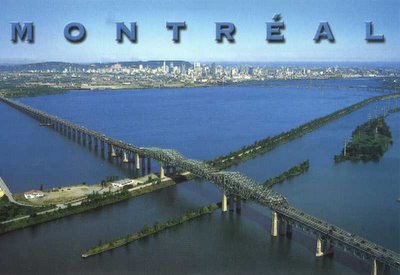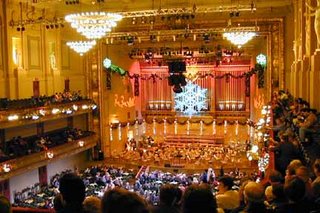 The city of Montreal
The city of Montreal is the second largest city in Canada and the largest city in the province of Quebec.
At the 2001 Canadian Census, there were 1,583,590 people living on the current territory of the city of Montreal proper, the population of the Montreal
Census Metropolitan Area is estimated at 3,635,700 in 2005 making it the second largest French-speaking metropolitan area in the world.
Montreal is ranked as the 30th largest metropolitan area in the Americas and 77th in the world
The tallest leaning tower in Montreal hovering at an angle of 45-degree over the Olympic stadium in the city.

Originally the tower that was built in 1987 was designed simply to be a mast for the cables holding up the roof of the stadium. The idea now is to turn the tower into an office building with 2-storey observation desk at the top and ground-level sport center and pools. Observatory will provide an excellent 50-miles view and together with the sport facilities they will be opened to the general public and to the expected 1,500 people that will work at the leaning tower. Some of the sport facilities are really impressive - 250-meter-long pool, diving pool and children's pool.

The stadium and the tower are among Montreal's most popular attractions. They are also on the walking distance from the nearby Botanic Gardens, which are considered to be among the best in Canada and also from the local Insectarium and Biodome, other two Montreal landmarks.
Montreal's Underground City (French: La ville souterraine) is the well-known underground city complex in downtown Montreal, Quebec, Canada. It is also known as the indoor city (ville intérieure) as not all of it is underground.
In 2004 the underground city was rebranded and given the name RÉSO,the name RÉSO is based on the French word réseau, or network (as in a network of tunnels).

The first link of the underground city arose with the construction of the Place Ville-Marie office tower and underground shopping mall, built in 1962 to cover an unsightly pit of railway tracks north of the Gare Centrale. A tunnel joined it to Gare Centrale and the Queen Elizabeth Hotel.

Directional panels to buildings accessible through the underground city, in Bonaventure metro stationThe advent of the Montreal metro in 1966 brought tunnels joining Bonaventure station to the Château Champlain hotel, the Place du Canada office tower, Place Bonaventure, Gare Centrale, and Gare Windsor, forming the core of the Underground City. Square-Victoria station connected to the Tour de la Bourse, Montreal's stock exchange building.
Mount Royal is a very special part of Montréal’s heritage. Its landscapes, flora, fauna and history make it an exceptional place to visit. Many services are available to help you explore this natural monument in the city’s centre.
The mountain is the site of Mount Royal Park (officially Parc du Mont-Royal), one of Montreal's largest greenspaces. The park, most of which is wooded, was designed by Frederick Law Olmsted, who also designed New York's Central Park, and inaugurated in 1876.


The park contains two belvederes, the more prominent of which is the Kondiaronk Belvedere, a semicircular plaza with a chalet, overlooking downtown Montreal. Other features of the park are Lac aux Castors (Beaver Lake), a small man-made lake; a short ski slope; a sculpture garden; Maison Smith, an interpretive centre; and a well-known monument to Sir George-Étienne Cartier
I think that montreal is a very nice city, it has very interesting places to visit and to live. It has a combination between neoclasical and victorian style of architecture, for example there is a big skycraper and a very old church.
One thing that i liked it is the leaning tower and the underground city too, because it is one of the bigest subterranean cities in the world because the xtreme weather of Montreal.






























